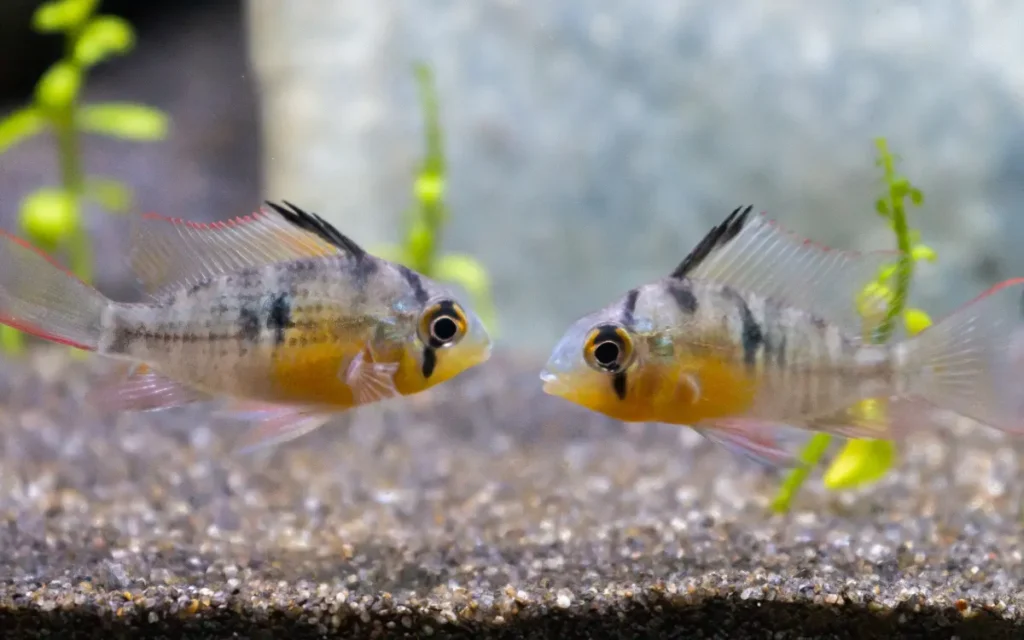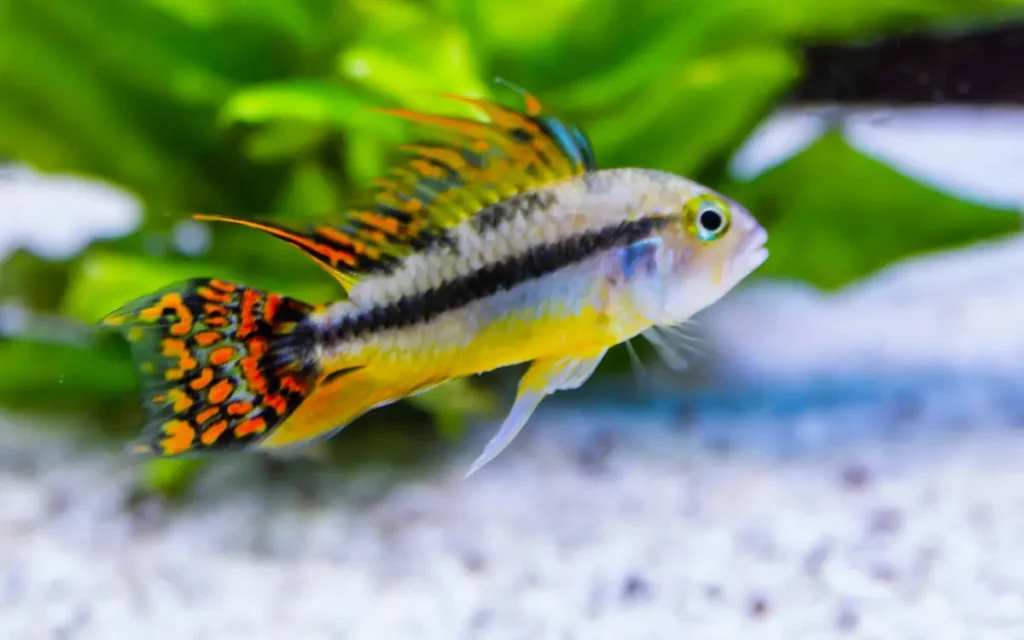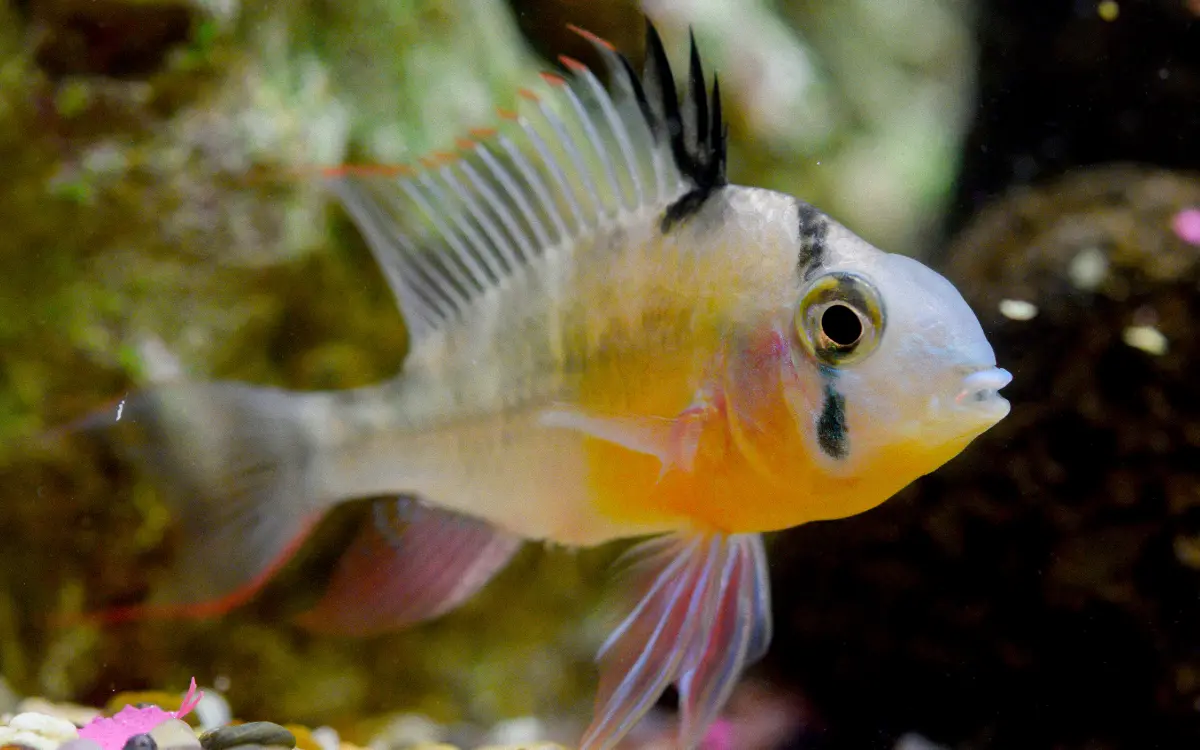The Bolivian Ram is a colorful, peaceful cichlid known for its gentle nature and striking appearance, making it a popular choice for community aquariums and an excellent addition to any freshwater tank.
| Attribute | Details |
| Family | Cichlidae |
| Aggressiveness | Peaceful, though can be territorial during breeding |
| Minimum Tank Size | 20 gallons (75 liters) |
| Life Span | 4-6 years |
| Diet | Omnivore (flakes, pellets, live or frozen foods such as brine shrimp and bloodworms) |
| Size | Up to 3 inches (7.5 cm) |
| Compatibility | Compatible with other peaceful fish like Tetras, Corydoras, and small Plecos |
| Temperament | Calm, social, and generally peaceful with occasional territorial behavior during spawning |
Tank Setup for Bolivian Ram

Tank Size:
A minimum of 20 gallons (75 liters) is recommended to provide ample space for the Bolivian Ram and its tank mates.
Substrate:
Use fine sand or smooth gravel as the substrate to mimic their natural habitat and support their foraging behavior.
Plants:
Include live plants like Amazon Sword, Java Fern, and Anubias. These plants provide hiding spots and help maintain water quality.
Decor:
Add driftwood, rocks, and caves to create hiding spots and territories. These structures help reduce stress and encourage natural behaviors.
Water Temperature:
Maintain the water temperature between 72-79°F (22-26°C) to ensure their comfort and health.
Water pH:
Keep the pH level between 6.0 and 7.5. Bolivian Rams prefer slightly acidic to neutral water conditions.
Water Hardness:
The ideal water hardness should be between 5-15 dGH to replicate their natural environment.
Lighting:
Provide moderate lighting to support plant growth and maintain a natural day-night cycle for the fish.
Filtration:
Use a gentle but efficient filtration system to keep the water clean without creating strong currents. Bolivian Rams prefer calm waters.
Aeration:
Ensure adequate aeration to maintain proper oxygen levels, which can be achieved with an air pump or by using a filter with surface agitation.
Water Changes:
Perform regular water changes of 20-30% weekly to maintain optimal water quality and prevent the buildup of harmful substances.
Tank Mates:
Choose peaceful tank mates such as Tetras, Corydoras, and small Plecos. Avoid aggressive or overly active fish that may stress the Bolivian Rams.
Feeding Bolivian Ram

Diet:
Bolivian Rams are omnivores and require a balanced diet consisting of both plant and animal matter to thrive.
Flake Food:
High-quality flake food should form the basis of their diet. Opt for products designed for cichlids to ensure they receive all essential nutrients.
Pellets:
Cichlid pellets or micro pellets can be offered as an alternative or supplement to flake food. These are especially good for providing a well-rounded diet.
Live Food:
Include live foods such as brine shrimp, daphnia, and bloodworms occasionally. Live foods are excellent for stimulating natural hunting behaviors and providing high-quality protein.
Frozen Food:
Frozen versions of live foods, like brine shrimp, bloodworms, and mysis shrimp, are convenient alternatives that can be easily stored and used when needed.
Vegetable Matter:
Incorporate blanched vegetables such as spinach, zucchini, and peas into their diet occasionally. This helps provide necessary plant-based nutrients and fiber.
Feeding Frequency:
Feed Bolivian Rams small amounts 2-3 times daily. It’s better to feed them smaller portions multiple times a day than one large meal to prevent overfeeding and ensure all fish get a chance to eat.
Portion Size:
Only provide as much food as they can consume in 2-3 minutes. Overfeeding can lead to water quality issues and health problems for the fish.
Supplementary Foods:
Occasionally add specialized foods like spirulina flakes or high-protein fry food to diversify their diet and support their health, especially if you are breeding them.
Observation:
Regularly observe your fish during feeding to ensure all individuals are eating properly. This can help you spot any potential health issues early and ensure even distribution of food.
Breeding Bolivian Ram
Tank Setup for Breeding:
- Separate Breeding Tank: Use a separate breeding tank with a minimum size of 20 gallons (75 liters). This tank should be well-planted and have plenty of hiding spots.
- Substrate: Use fine sand or smooth gravel to create a comfortable environment for egg laying.
- Decor: Provide flat stones or broad leaves for the Rams to lay their eggs on. Caves and driftwood can also help create a suitable breeding environment.
- Water Conditions: Maintain a water temperature between 77-82°F (25-28°C), a pH of 6.5-7.0, and a hardness of 5-12 dGH.
Conditioning the Fish:
- Select Healthy Breeders: Choose a healthy pair of Bolivian Rams. Males are typically larger and more colorful, with pointed dorsal fins, while females are rounder, especially when full of eggs.
- Feed High-Quality Food: Condition the breeders by feeding them a varied diet of high-quality flakes, live foods (like brine shrimp and daphnia), and frozen foods to encourage spawning.
Spawning Process:
- Introduce Breeders: Introduce the conditioned pair to the breeding tank. Bolivian Rams form monogamous pairs and often engage in pre-spawning behavior such as cleaning a flat surface together.
- Monitor for Spawning: The female will lay eggs on a flat surface, and the male will fertilize them. This can happen over several hours, during which the pair will become more territorial.
After Spawning:
- Egg Care: Both parents will guard the eggs, which will hatch in about 2-3 days. The fry will become free-swimming approximately 5-7 days after hatching.
- Remove Other Fish: If the breeding tank contains other fish, remove them to prevent them from eating the eggs or fry.
Raising Fry:
- Feeding: Once the fry are free-swimming, start feeding them infusoria or commercially available liquid fry food. As they grow, transition them to finely crushed flake food or powdered fry food.
- Water Quality: Maintain excellent water quality by performing regular water changes. Use an air-driven sponge filter to provide gentle filtration without harming the fry.
Growth and Development:
- Monitor Growth: Keep an eye on the fry’s growth and health. Separate any significantly larger individuals to prevent bullying and ensure even growth.
- Transition to Main Tank: Once the fry are large enough not to be eaten (usually around 1 inch or 2.5 cm), they can be gradually acclimated and introduced to the main tank.
Bolivian Ram Tank Mates
Ideal Tank Mates:
- Neon Tetras: Small, peaceful fish that add vibrant colors to the tank and share similar water parameters.
- Cardinal Tetras: Another small, peaceful tetra species that can coexist well with Bolivian Rams.
- Harlequin Rasboras: Active and peaceful fish that school well and complement the Bolivian Rams.
- Corydoras Catfish: Bottom-dwelling fish that are peaceful and help keep the tank clean.
- Rummy Nose Tetras: Peaceful schooling fish that thrive in similar water conditions.
- Otocinclus Catfish: Small algae eaters that are non-aggressive and beneficial for tank cleanliness.
- Dwarf Gourami: Peaceful and colorful fish that can coexist with Bolivian Rams if the tank is large enough.
- Cherry Barbs: Peaceful barbs that add a splash of color and are generally compatible.
- Kuhli Loaches: Bottom dwellers that are peaceful and help maintain the substrate.
- Plecos (Small species): Such as the Bristlenose Pleco, which are good for algae control and are peaceful tank mates.
FAQs
Are rams peaceful fish?
Yes, Bolivian Rams are generally peaceful fish. They are known for their calm and social behavior, although they can become slightly territorial during breeding. They are suitable for community tanks with other peaceful species.
Are Bolivian rams hard to keep?
No, Bolivian Rams are not particularly hard to keep. They are relatively hardy and adaptable to a range of water conditions, making them suitable for both beginner and experienced aquarists. However, maintaining good water quality and providing a proper diet are essential.
Can Rams live with guppies?
Yes, Bolivian Rams can live with guppies. Both species are peaceful and have similar water requirements, making them compatible tank mates. Ensure that the tank is large enough to provide space and hiding spots for both species.
What fish cannot live with bettas?
Avoid housing bettas with aggressive or fin-nipping fish such as Tiger Barbs, Red Tail Sharks, and certain types of Cichlids. Additionally, other bettas should not be kept together, as they are territorial and can become aggressive towards each other.

